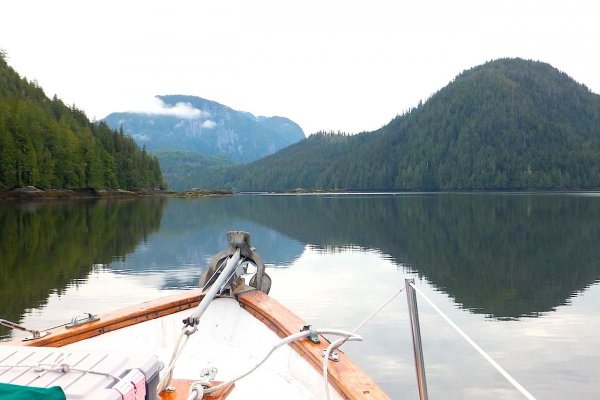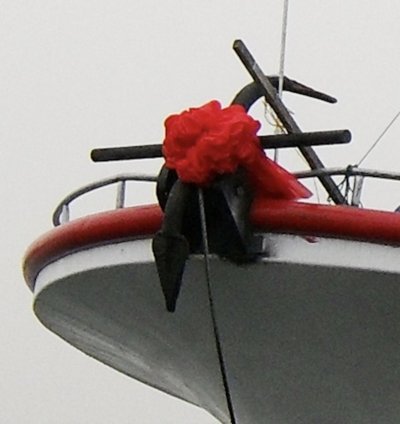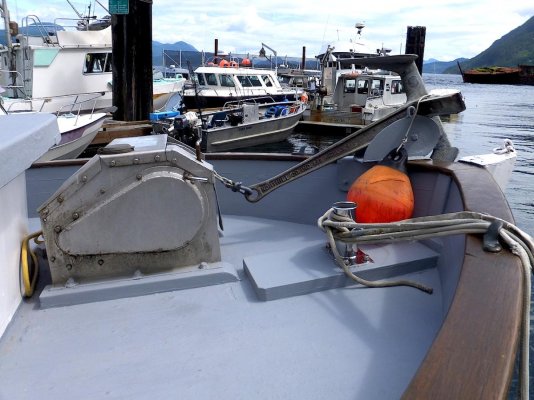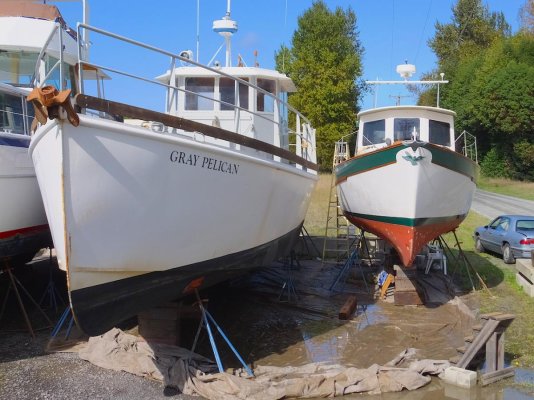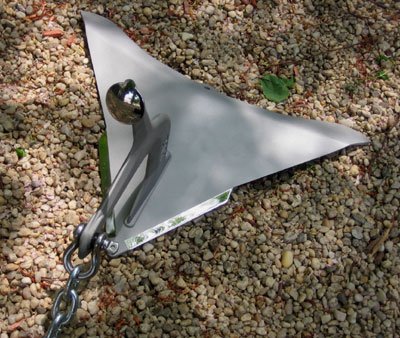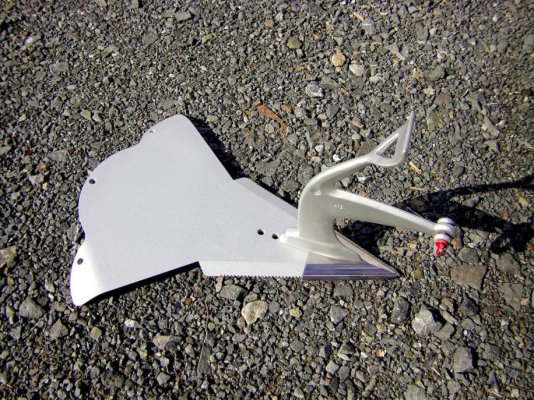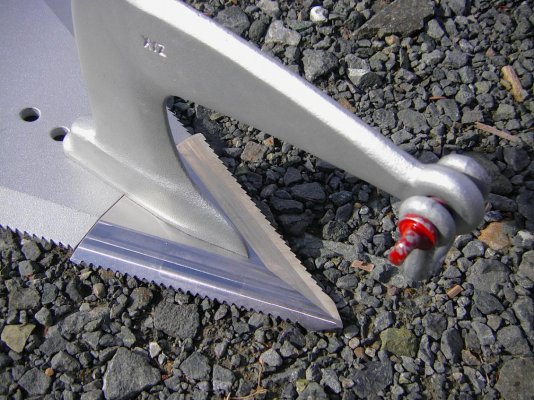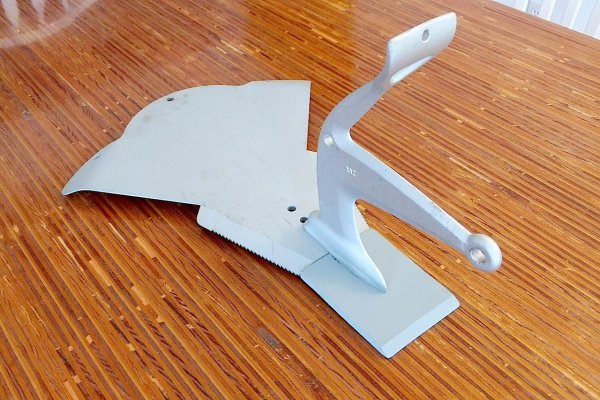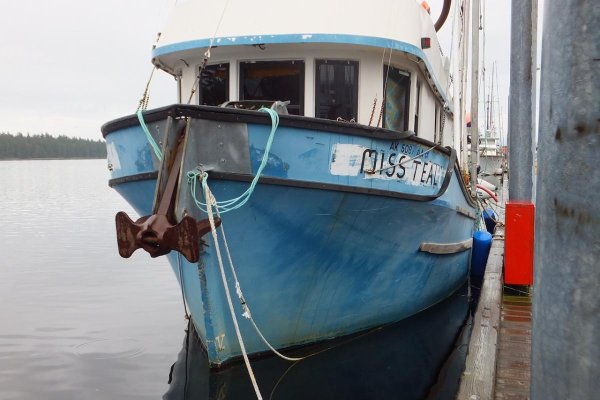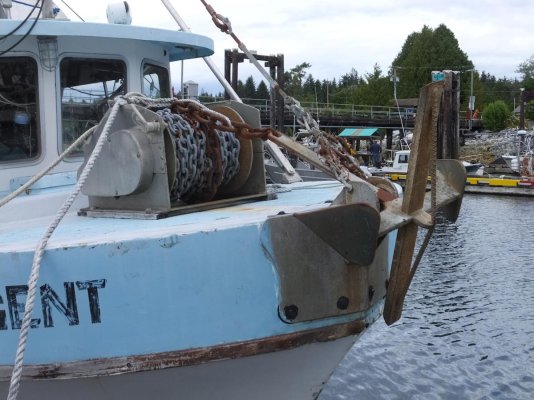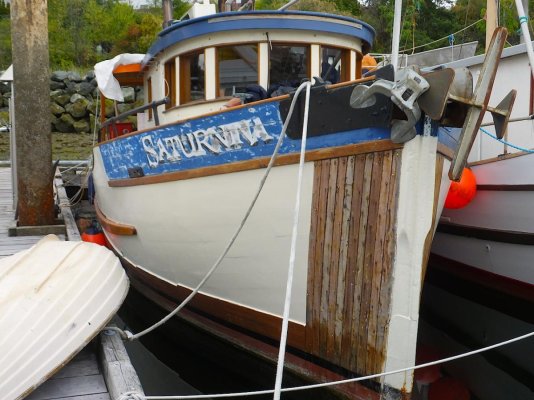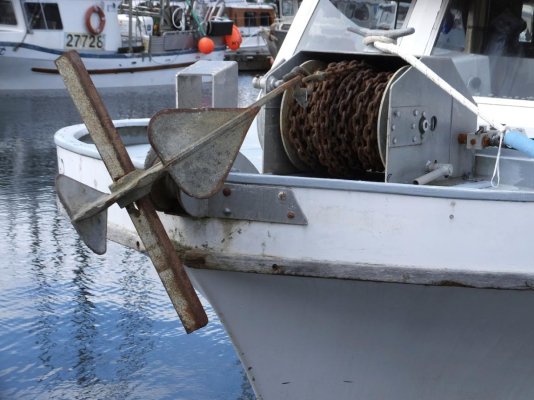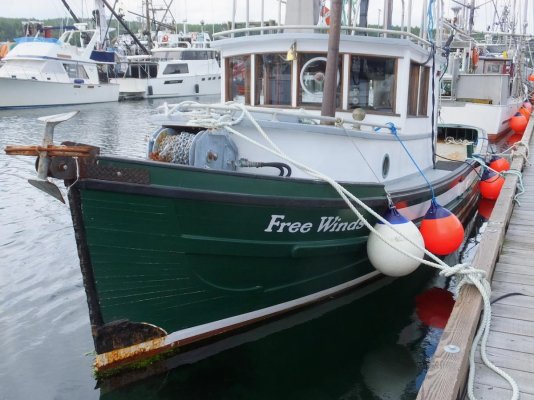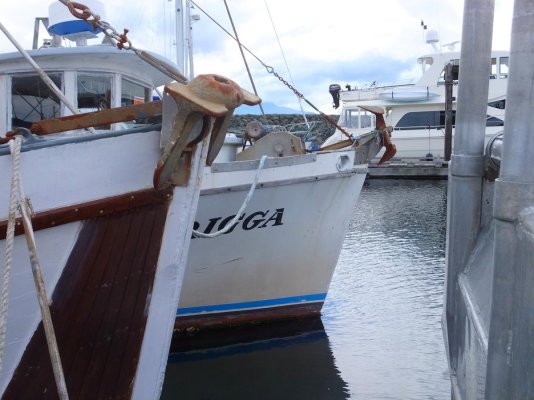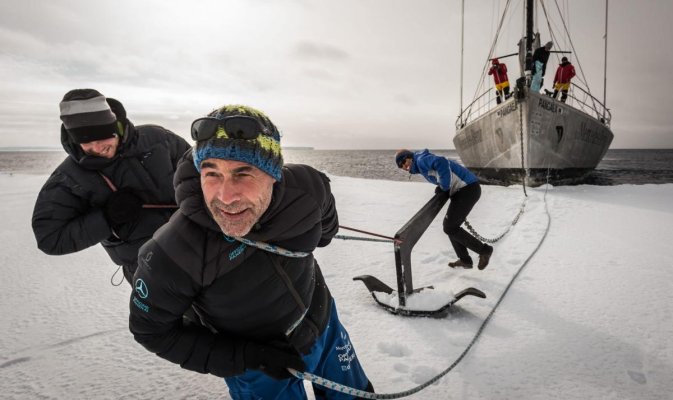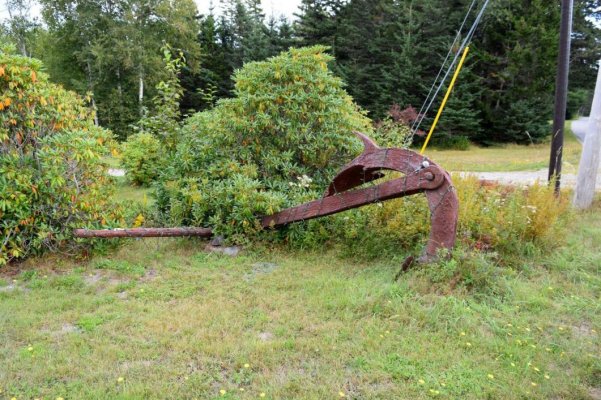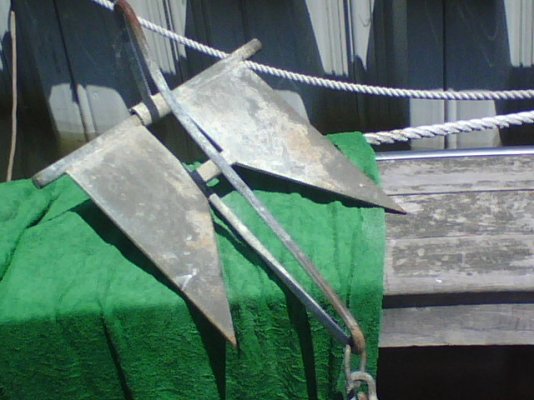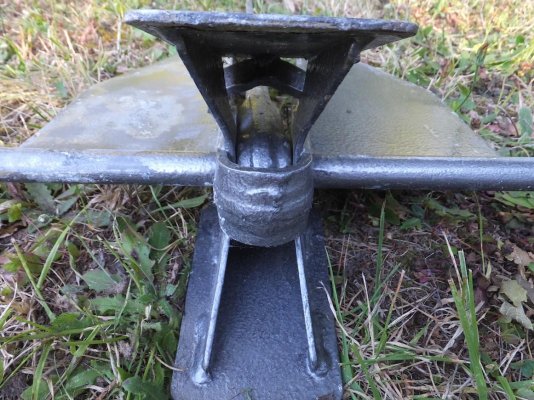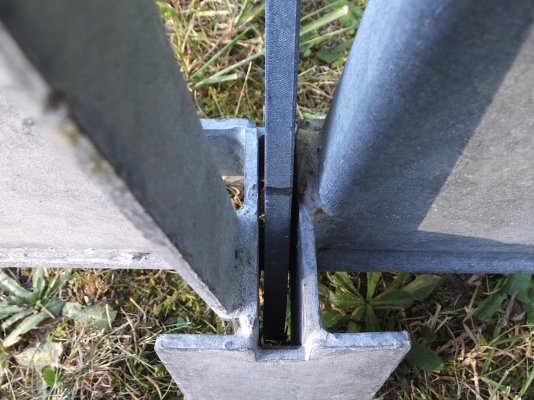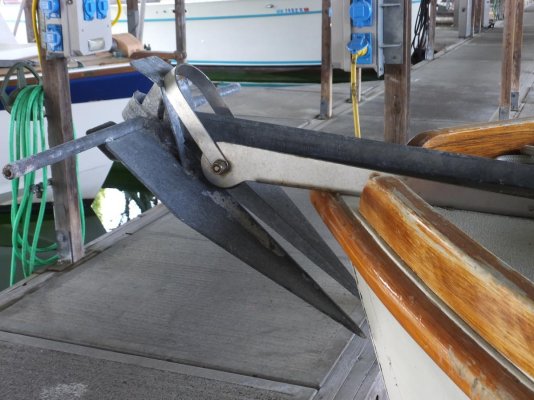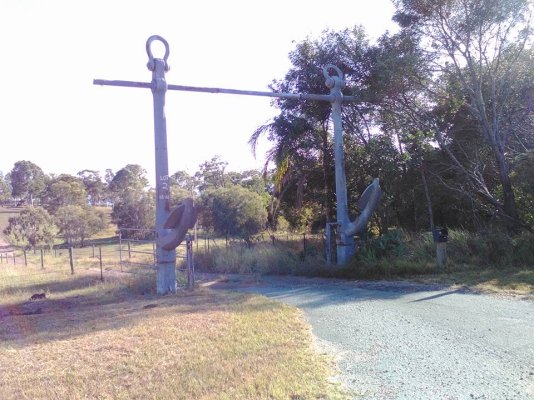You are using an out of date browser. It may not display this or other websites correctly.
You should upgrade or use an alternative browser.
You should upgrade or use an alternative browser.
Interesting Anchors
- Thread starter BruceK
- Start date
The friendliest place on the web for anyone who enjoys boating.
If you have answers, please help by responding to the unanswered posts.
If you have answers, please help by responding to the unanswered posts.
BruceK
Moderator Emeritus
- Joined
- Oct 31, 2011
- Messages
- 13,549
- Vessel Name
- Sojourn
- Vessel Make
- Integrity 386
The Flook Anchor
I found this engaging video from Dulmison, inventors of the Flook Anchor.
Hoped it would explain what powers it into underwater flight, but it doesn`t. But don`t dismiss it as BS, Phil Dulhunty of Dulmison does exist, and so did Dulmison, they built my 26ft "Folkboat" sailing yacht, and indeed, pics show it being launched from the bow of a Folkboat.
FYI, the Folkboat design resulted from a Scandinavian sailboat design competition post WW2. It was a sturdy tough slow little long/full keel 7/8 rig boat with a keel/transom mounted rudder, and about the last thing, along with the open Jubilee class boats, to be blown off Sydney Harbour on a rough Saturday afternoon of racing. A grandmother sailed one, solo but not nonstop, around the world. They were raced in San Francisco too.
But I digress. Anyone know what powers the mighty Flook? Maybe if I watched the vid to the end.....
I found this engaging video from Dulmison, inventors of the Flook Anchor.
Hoped it would explain what powers it into underwater flight, but it doesn`t. But don`t dismiss it as BS, Phil Dulhunty of Dulmison does exist, and so did Dulmison, they built my 26ft "Folkboat" sailing yacht, and indeed, pics show it being launched from the bow of a Folkboat.
FYI, the Folkboat design resulted from a Scandinavian sailboat design competition post WW2. It was a sturdy tough slow little long/full keel 7/8 rig boat with a keel/transom mounted rudder, and about the last thing, along with the open Jubilee class boats, to be blown off Sydney Harbour on a rough Saturday afternoon of racing. A grandmother sailed one, solo but not nonstop, around the world. They were raced in San Francisco too.
But I digress. Anyone know what powers the mighty Flook? Maybe if I watched the vid to the end.....
Nomad Willy
Guru
Bruce,
Gravity I’d say. It just glides .... like a glider.
Don’t recall one flying horizontally like a powered aircraft. Having flown a lot of gliders, and built one it never occurred to me the Flook anchor was acting like an powered airplane. But I did wonder why it apparently designed to glide away from the boat. Perhaps it was to insure (sorta) that it assumed it’s position on the seafloor right side up. Thus the “inboard flaps” then got pulled in the direction to dig in like Danforth flukes. Also the Flook needed considerable scope to work. It seemed to have a glide ratio of about 8-1. Quite respectable for a glider.
So I’m say’in gravity “powers” it.
Gravity I’d say. It just glides .... like a glider.
Don’t recall one flying horizontally like a powered aircraft. Having flown a lot of gliders, and built one it never occurred to me the Flook anchor was acting like an powered airplane. But I did wonder why it apparently designed to glide away from the boat. Perhaps it was to insure (sorta) that it assumed it’s position on the seafloor right side up. Thus the “inboard flaps” then got pulled in the direction to dig in like Danforth flukes. Also the Flook needed considerable scope to work. It seemed to have a glide ratio of about 8-1. Quite respectable for a glider.
So I’m say’in gravity “powers” it.
Last edited:
Nomad Willy
Guru
Bob,
What’s been your experiences re setting, veering and perhaps short scope. I have an anchor quite similar to the Navy. Only significant difference is that the “Dreadnought” (named after WWI battleships I suppose) is it extra long shank. I read somewhere that they needed very little scope. By contrast the Navy anchor has a short shank. The Navy lacks the long heavy shank acting a bit like heavy chain holding down the shank. But the Navy’s shank being short would be less likely to lever the flukes up and out of the seafloor.
I only used the Dreadnought once. It was like somebody was down there setting the anchor. It didn’t need a bit of dragging (setting). Right off the bat it didn’t move. Picture was approaching the anchorage in the upper Broughtons w the Dread all mounted up and ready to go. The very long shank is quite evident in this pic.
What’s been your experiences re setting, veering and perhaps short scope. I have an anchor quite similar to the Navy. Only significant difference is that the “Dreadnought” (named after WWI battleships I suppose) is it extra long shank. I read somewhere that they needed very little scope. By contrast the Navy anchor has a short shank. The Navy lacks the long heavy shank acting a bit like heavy chain holding down the shank. But the Navy’s shank being short would be less likely to lever the flukes up and out of the seafloor.
I only used the Dreadnought once. It was like somebody was down there setting the anchor. It didn’t need a bit of dragging (setting). Right off the bat it didn’t move. Picture was approaching the anchorage in the upper Broughtons w the Dread all mounted up and ready to go. The very long shank is quite evident in this pic.
Attachments
Last edited:
This is the type of northill anchor I was referring to. I couldn't find my photos from Vietnam where you could see how they were welded up, but this screen grab from a Chinese shipyard shows pretty well. Pretty much all trawlers 35m and smaller are outfitted with these. I believe they are all fabricated at the shipyard because you never see these for sale on Alibaba or MadeInChina or other sites. The one in the photo is 300 lbs (140kg) but I think it could use larger and sharper flukes.
Attachments
C lectric
Guru
Mako,
Here's the home made SS Northill. Saw it in Shawl Bay in the upper Broughton Is. He was a clever fellow as evidnced by his boat details.
Scowndrel's Dream, the boats name.
Nomad Willy
Guru
Scowdrel's Dream .... indeed it was.
We were about to have the pancakes the big fellow there was famous for.
We were about to have the pancakes the big fellow there was famous for.
Nomad Willy
Guru
Mako that looks like a Kedge anchor. Some call them a fishermen's anchor. But The best of the type is a Herreshoff anchor.
the Luke anchor is a modern day source for this type of anchor.
I don't have much on them but Steve tested a 100lb "Luke" in his "Anchor Setting
Videos".
The anchor in your pic looks like the inexpensive anchor used by fishermen to hold their gear in place on the seafloor. Traps and long hook lines. They appear to be very inexpensive with very small flukes like in your pic.
I should add that the anchor in your post is not a Northill.
This is a real/original Nothhill anchor./Users/eric/Desktop/bronze1-
2.HERRESHOFF’S BRONZE 3-PIECE
FOLDING STOCK ANCHORS
Licensed by the Hart Nautical Collections at M.I.T. ~ Authorized by the Herreshoff Marine Museum
After centuries of evolution, culminating with the Herreshoffs’ refinements, “The genuine Herreshoff anchor is a truly wonderful creation and has yet to be improved upon for all-around use.”* We manufacture them in high strength bronze (equal in strength to cast iron) and have added one more innovation; the stock is secured by threading it into the shank for easy, fast, neat and secure setup with no loose parts. (7½ & 21 lb. Anchors)
Perfected by Nat Herreshoff over many years, these anchors have been widely copied, but never duplicated from Herreshoff drawings until now. The 7½ pounder was standard equipment on the famous 12½s, and on Captain Nat’s personal boat Alerion III. They are ideal for small boats because they are dependable, light, easily handled, fold flat for storage, can be carried near the compass without affecting it, and they will not stain your belongings because they do not rust.
The versatility of these anchors is unparalleled. They will hold equally well in weeds, sand, mud, or rocky bottoms and unlike most modern anchors, do not bring up huge clumps of mud and weeds, and are easily cleaned. Because these anchors don’t need heavy, messy and hard to handle chain to get them to set, they are much less likely to damage your hands and topsides when brought aboard and if the weight of the chain needed by others is considered, ours equals their holding power pound for pound, are more easily stowed and, of course, much more aesthetically pleasing. Our 17lb. anchor, recently tested in Practical Sailor’s, Jan./01 Anchor Reset Tests, ranked 8th out of 17 for Holding Power (pound-for-pound) in sand, beating both the CQR & Bruce, and 6th in Setting. (More testing to come.) No wonder these anchors have continued to be popular!
* Maynard Bray and Carlton Pinheiro, Herreshoff of Bristol, Brooklin, ME; WoodenBoat Publications, 1989
7½ lb. Length 25” x 16” width x 2½” palm width (Above) $295 + $17.00 shipping (USA)
12 lb. Coming Soon
17 lb. Length 29” x 18½” width x 3 5/16” palm width $425 + $24.00 shipping (USA)
21 lb. Length 33” x 21” width x 3 9/16” palm width $525 + $35.00 shipping (USA)
the Luke anchor is a modern day source for this type of anchor.
I don't have much on them but Steve tested a 100lb "Luke" in his "Anchor Setting
Videos".
The anchor in your pic looks like the inexpensive anchor used by fishermen to hold their gear in place on the seafloor. Traps and long hook lines. They appear to be very inexpensive with very small flukes like in your pic.
I should add that the anchor in your post is not a Northill.
This is a real/original Nothhill anchor./Users/eric/Desktop/bronze1-
2.HERRESHOFF’S BRONZE 3-PIECE
FOLDING STOCK ANCHORS
Licensed by the Hart Nautical Collections at M.I.T. ~ Authorized by the Herreshoff Marine Museum
After centuries of evolution, culminating with the Herreshoffs’ refinements, “The genuine Herreshoff anchor is a truly wonderful creation and has yet to be improved upon for all-around use.”* We manufacture them in high strength bronze (equal in strength to cast iron) and have added one more innovation; the stock is secured by threading it into the shank for easy, fast, neat and secure setup with no loose parts. (7½ & 21 lb. Anchors)
Perfected by Nat Herreshoff over many years, these anchors have been widely copied, but never duplicated from Herreshoff drawings until now. The 7½ pounder was standard equipment on the famous 12½s, and on Captain Nat’s personal boat Alerion III. They are ideal for small boats because they are dependable, light, easily handled, fold flat for storage, can be carried near the compass without affecting it, and they will not stain your belongings because they do not rust.
The versatility of these anchors is unparalleled. They will hold equally well in weeds, sand, mud, or rocky bottoms and unlike most modern anchors, do not bring up huge clumps of mud and weeds, and are easily cleaned. Because these anchors don’t need heavy, messy and hard to handle chain to get them to set, they are much less likely to damage your hands and topsides when brought aboard and if the weight of the chain needed by others is considered, ours equals their holding power pound for pound, are more easily stowed and, of course, much more aesthetically pleasing. Our 17lb. anchor, recently tested in Practical Sailor’s, Jan./01 Anchor Reset Tests, ranked 8th out of 17 for Holding Power (pound-for-pound) in sand, beating both the CQR & Bruce, and 6th in Setting. (More testing to come.) No wonder these anchors have continued to be popular!
* Maynard Bray and Carlton Pinheiro, Herreshoff of Bristol, Brooklin, ME; WoodenBoat Publications, 1989
7½ lb. Length 25” x 16” width x 2½” palm width (Above) $295 + $17.00 shipping (USA)
12 lb. Coming Soon
17 lb. Length 29” x 18½” width x 3 5/16” palm width $425 + $24.00 shipping (USA)
21 lb. Length 33” x 21” width x 3 9/16” palm width $525 + $35.00 shipping (USA)
Attachments
Last edited:
BruceK
Moderator Emeritus
- Joined
- Oct 31, 2011
- Messages
- 13,549
- Vessel Name
- Sojourn
- Vessel Make
- Integrity 386
It might be trained to glide away from the boat so it doesn`t attack the hullBruce,
Gravity I’d say. It just glides .... like a glider.
Don’t recall one flying horizontally like a powered aircraft. Having flown a lot of gliders, and built one it never occurred to me the Flook anchor was acting like an powered airplane. But I did wonder why it apparently designed to glide away from the boat. Perhaps it was to insure (sorta) that it assumed it’s position on the seafloor right side up. Thus the “inboard flaps” then got pulled in the direction to dig in like Danforth flukes. Also the Flook needed considerable scope to work. It seemed to have a glide ratio of about 8-1. Quite respectable for a glider.
So I’m say’in gravity “powers” it.
Wayfarer
Guru
- Joined
- Aug 29, 2014
- Messages
- 2,228
- Location
- USA
- Vessel Name
- Sylphide
- Vessel Make
- Kingston Aluminum Yacht 44' Custom
Say Bob, that's pretty close to the sort of thing that most commercial ships use. When I was in school, they drummed it into our heads that the anchor itself doesn't have all that much holding power, and that it's the combined weight of the hook and the chain dragging on the bottom that really does the work.
Has that been your experience? Does it dig in much? Do you have to veer out more scope with Seafarer?
Nomad Willy
Guru
FYI Wayfarer,
The larger boat (50') usta go to Alaska every year in this 50' steel boat and for quite a number of years he always had this rusty old Navy anchor proudly on the bow. He said it served him well. Happy camper as they say.
Little boat is mine.
The larger boat (50') usta go to Alaska every year in this 50' steel boat and for quite a number of years he always had this rusty old Navy anchor proudly on the bow. He said it served him well. Happy camper as they say.
Little boat is mine.
Attachments
Nomad Willy
Guru
Interesting Anchor
In about 06 I was w my new old boat only w a 13lb Danforth anchor. Didn'd look big enough to me. I had little knowledge about anchors but I read an anchor test and an anchor called the XYZ out performed all the other anchors on holding power. So I searched about and bought one. 13lbs as seen in my last picture. It was very well made and we started using it.
That didn't go smoothly. Frequently it took several attempts to get set and if the weather isn't nice on the foredeck multiple tries at setting got tiresome. I read about a setting method that I still adhere to in challenging situations. That was basically to lower the anchor slowly while drifting very slowly backwards thereby laying out the rode behind the anchor in a line w the anchors fluke pointing at the boat. Then w about 3-4 to one scope out I'd cleat off the rode and let the anchor stop the boat. A very subtle act as the boat was moving very slowly. Then I'd give repeated short bumps of power at idle until I figured the anchor was truly engaging and penetrating the sea floor. A follow up of reverse power of 12-1400rpm usuallly finished the job.
But over time this became burdensome. And at times it didn't work. When that happened I deployed my original 13lb Danforth. An S class Danforth. The Dan always held.
I've anchored through two 50 knot gales. One in northern BC in Allison Harbour and one in also in northern BC in Patterson Inlet in the middle of Principe Channel near Anger Is.
In Allison Harbour the wind thrashed the boat back and forth sideways violently jerking on the rode. This was a big storm that lasted a day and a half. There was no dragging at all as far as we could tell.
The next gale we anchored in was at Patterson Inlet near Anger Is. We knew the gale was coming as we did the last time. But w a 6 knot boat getting to a suitable harbor was a questionable option. We anchored w two other boats w suficient swinging room ..basically enough.
This gale was a little stronger but only lasted through the night. This time we had a slightly modified XYZ Extreme anchor (third pic). I couldn't obtain a fluke tip and was forced to make one. Ugly compared to the original but a small increase in blade area. I can't say why but we had less sailing this time but more wind. The boat in front of us (KK42) was dragging toward us and he showed no interest in pulling up his anchor and resetting .. so we did as he was getting tool close and I didn't want to be out on the foredeck if the wind increased. We assumed his original position. The re anchoring was succesful .. at the mouth of a large stream/small river. Then it got very dark. All we could see was the running and anchor lights of the other two boats. The other boat (45' or so sailboat) w a big CQR also reanchored but didn't move much. The sailboat didn't drag. It was a long night w 2 hour watches. We felt the wind would never abate but come morning (before much light) it came to an end.
So that was two gales under our belt w XYZ anchors. The first was w the original production/prototype anchor of 13lbs. The Patterson Inlet (sometimes called Princes Diana Inlet) event we had a newer XYZ anchor called the Extreme. Shown in my pic #1 and 2. This newer anchor is 18lbs.
We used the Extreme all the way down to Washington from near Ketchikan. That was quite a few years ago and had no problems. But had trouble setting in Fisherman's Bay later on. I suspect a grass problem and if we had had the original fluke tip the problem may not have occured.
There's a lesson here for all. Picking an anchor w the highest holding power in an anchor test dosn't mean you've got the best anchor. I can think of 5-6 more attributes in anchor performance that easily exceed holding power in value re how good an anchor is. To have extremely good setting performance would be worth 20 to 40% less holding power. Most modern anchors have such high holding power it's no longer such a high priority. In a gale w all your other ducks in a row it disn'nt matter if you have a Spade, a Rocna, an Excel or a Supreme or perhaps a Super Max. The most important variable in anchoring actually has nothing to do w the anchor but all to do w the seafloor under your boat.
For the curious you can see the XYZ website at xyzanchor.com.
I'm not promoting this anchor and if you have any inclinations about using it please PM me first.
In about 06 I was w my new old boat only w a 13lb Danforth anchor. Didn'd look big enough to me. I had little knowledge about anchors but I read an anchor test and an anchor called the XYZ out performed all the other anchors on holding power. So I searched about and bought one. 13lbs as seen in my last picture. It was very well made and we started using it.
That didn't go smoothly. Frequently it took several attempts to get set and if the weather isn't nice on the foredeck multiple tries at setting got tiresome. I read about a setting method that I still adhere to in challenging situations. That was basically to lower the anchor slowly while drifting very slowly backwards thereby laying out the rode behind the anchor in a line w the anchors fluke pointing at the boat. Then w about 3-4 to one scope out I'd cleat off the rode and let the anchor stop the boat. A very subtle act as the boat was moving very slowly. Then I'd give repeated short bumps of power at idle until I figured the anchor was truly engaging and penetrating the sea floor. A follow up of reverse power of 12-1400rpm usuallly finished the job.
But over time this became burdensome. And at times it didn't work. When that happened I deployed my original 13lb Danforth. An S class Danforth. The Dan always held.
I've anchored through two 50 knot gales. One in northern BC in Allison Harbour and one in also in northern BC in Patterson Inlet in the middle of Principe Channel near Anger Is.
In Allison Harbour the wind thrashed the boat back and forth sideways violently jerking on the rode. This was a big storm that lasted a day and a half. There was no dragging at all as far as we could tell.
The next gale we anchored in was at Patterson Inlet near Anger Is. We knew the gale was coming as we did the last time. But w a 6 knot boat getting to a suitable harbor was a questionable option. We anchored w two other boats w suficient swinging room ..basically enough.
This gale was a little stronger but only lasted through the night. This time we had a slightly modified XYZ Extreme anchor (third pic). I couldn't obtain a fluke tip and was forced to make one. Ugly compared to the original but a small increase in blade area. I can't say why but we had less sailing this time but more wind. The boat in front of us (KK42) was dragging toward us and he showed no interest in pulling up his anchor and resetting .. so we did as he was getting tool close and I didn't want to be out on the foredeck if the wind increased. We assumed his original position. The re anchoring was succesful .. at the mouth of a large stream/small river. Then it got very dark. All we could see was the running and anchor lights of the other two boats. The other boat (45' or so sailboat) w a big CQR also reanchored but didn't move much. The sailboat didn't drag. It was a long night w 2 hour watches. We felt the wind would never abate but come morning (before much light) it came to an end.
So that was two gales under our belt w XYZ anchors. The first was w the original production/prototype anchor of 13lbs. The Patterson Inlet (sometimes called Princes Diana Inlet) event we had a newer XYZ anchor called the Extreme. Shown in my pic #1 and 2. This newer anchor is 18lbs.
We used the Extreme all the way down to Washington from near Ketchikan. That was quite a few years ago and had no problems. But had trouble setting in Fisherman's Bay later on. I suspect a grass problem and if we had had the original fluke tip the problem may not have occured.
There's a lesson here for all. Picking an anchor w the highest holding power in an anchor test dosn't mean you've got the best anchor. I can think of 5-6 more attributes in anchor performance that easily exceed holding power in value re how good an anchor is. To have extremely good setting performance would be worth 20 to 40% less holding power. Most modern anchors have such high holding power it's no longer such a high priority. In a gale w all your other ducks in a row it disn'nt matter if you have a Spade, a Rocna, an Excel or a Supreme or perhaps a Super Max. The most important variable in anchoring actually has nothing to do w the anchor but all to do w the seafloor under your boat.
For the curious you can see the XYZ website at xyzanchor.com.
I'm not promoting this anchor and if you have any inclinations about using it please PM me first.
Attachments
Last edited:
Slider70
Senior Member
When commercial fishing we worked 16 and 18 hour days. We anchored where ever the closest spot was where we could get a hook and a bit of shelter. Sleep time was short bunk then back to work. Dragging anchor was a major pain, lost sleep along with the obvious dangers.
Using the same rode but different anchors I found the best for my 41' boat in the many different bottoms was an original Northill, the dropped forged ones not the welded up copies. Once had a welded copy leave the flukes on the bottom when we retrieve it!
I have used a Danforth which worked well on some bottoms, poorly on others, a navy which didn't work well on many bottoms, and a Bruce with success. But overall I would literally hang with the Northill.
I now have a yacht. I use a Bruce. The Northill types do not stow well on a yacht to my eye while the Bruce does quickly. Tied in place it sits nicely and does the job I need doing.
The strange one initializing the original question I would personally walk away from. However, different boats call for different anchors re: weight, stowage, power, etc.
Using the same rode but different anchors I found the best for my 41' boat in the many different bottoms was an original Northill, the dropped forged ones not the welded up copies. Once had a welded copy leave the flukes on the bottom when we retrieve it!
I have used a Danforth which worked well on some bottoms, poorly on others, a navy which didn't work well on many bottoms, and a Bruce with success. But overall I would literally hang with the Northill.
I now have a yacht. I use a Bruce. The Northill types do not stow well on a yacht to my eye while the Bruce does quickly. Tied in place it sits nicely and does the job I need doing.
The strange one initializing the original question I would personally walk away from. However, different boats call for different anchors re: weight, stowage, power, etc.
Nomad Willy
Guru
Slider,
I like your input and the fact that you've used older anchors and seem to have a very objective relationship w them.
1. What other Claws have you used and can you compare their performance to your Bruce?
2. Why do fishermen insist on using some of the lowest holding power anchors? Looks like just a money issue to me. Cement in the seams of an old wood boat or house paint on the topsides seems to be motivated from the same economic forces. But I think some of it is related to setting dependability. And fishermen do have a DIY mentality. But you don't mention that and you do mention dragging. But the compatibility w bow mounting you also mention. I'm sure that one thing drove the Bruce sales in the beginning and to this day. I even wonder if the Claw anchor is still the top selling anchor and if mounting ease is still the reason.
I have a Northill but it's only 8-10 lbs. And my lightweight Northill type seaplane anchor. About 14lbs but it's rather large. Haven't tried either one. My seaplane anchor's one fluke is almost or is the same fluke size (or is) as my old XYZ in the photo above your post. and I sat out a 50 knot blow w it. And the seaplane anchor must get some holding power from the stock bars when they are pressed to the seafloor. May do better than I've thought. Sure wish we could buy a genuine Northill anchor.
I like your input and the fact that you've used older anchors and seem to have a very objective relationship w them.
1. What other Claws have you used and can you compare their performance to your Bruce?
2. Why do fishermen insist on using some of the lowest holding power anchors? Looks like just a money issue to me. Cement in the seams of an old wood boat or house paint on the topsides seems to be motivated from the same economic forces. But I think some of it is related to setting dependability. And fishermen do have a DIY mentality. But you don't mention that and you do mention dragging. But the compatibility w bow mounting you also mention. I'm sure that one thing drove the Bruce sales in the beginning and to this day. I even wonder if the Claw anchor is still the top selling anchor and if mounting ease is still the reason.
I have a Northill but it's only 8-10 lbs. And my lightweight Northill type seaplane anchor. About 14lbs but it's rather large. Haven't tried either one. My seaplane anchor's one fluke is almost or is the same fluke size (or is) as my old XYZ in the photo above your post. and I sat out a 50 knot blow w it. And the seaplane anchor must get some holding power from the stock bars when they are pressed to the seafloor. May do better than I've thought. Sure wish we could buy a genuine Northill anchor.
Nomad Willy
Guru
Big Kahuna
Some really get into the bigger is better thinking.
This pic was taken in Craig Ak about 11 years ago. As can be seen it's a huge Navy anchor. But it's not just his bower or working anchor but his mooring anchor as well.
He lived in a cabin on a small island that experienced strong winter winds and he was determined to keep his boat where it belonged. How many pounds you ask ..... 500.
Some really get into the bigger is better thinking.
This pic was taken in Craig Ak about 11 years ago. As can be seen it's a huge Navy anchor. But it's not just his bower or working anchor but his mooring anchor as well.
He lived in a cabin on a small island that experienced strong winter winds and he was determined to keep his boat where it belonged. How many pounds you ask ..... 500.
Attachments
Slider70
Senior Member
There is something to be said for weight. There is more to be said about design though. I found this style of anchor on my vessel when I purchased it, much less weight though, one of the worst for holding my 41' troller in the many different grounds I dropped a hook in. I change to a better holding hook after one season of dragging.
Nomad Willy
Guru
Slider70,
I often refer to them as little bulldozers and I've never heard of a Navy letting go or breaking out. Reports always sound like a very slow drag. And one can always pick it up and go back to do the same all night. If the dragging is slow enough it may not take many resets. But sleeping is better. It is amazing how many vessels still have have a Navy anchor on their bow ...... but perhaps some or many never get used. I don't have one and haven't tried them. I have a 35lb Dreadnought that is similar. I used it once but with no wind that I recall. It set instantly. It was like it landed on the bottom already set. And since they are non-penetrating anchors that adds up.
Thanks for your input.
Do you live in Burns Lake and go to the coast to fish?
I often refer to them as little bulldozers and I've never heard of a Navy letting go or breaking out. Reports always sound like a very slow drag. And one can always pick it up and go back to do the same all night. If the dragging is slow enough it may not take many resets. But sleeping is better. It is amazing how many vessels still have have a Navy anchor on their bow ...... but perhaps some or many never get used. I don't have one and haven't tried them. I have a 35lb Dreadnought that is similar. I used it once but with no wind that I recall. It set instantly. It was like it landed on the bottom already set. And since they are non-penetrating anchors that adds up.
Thanks for your input.
Do you live in Burns Lake and go to the coast to fish?
Nomad Willy
Guru
Anchors at Sointula
Some interesting anchors in Sointula. Sointula is on Malcom Is. So. of Port Hardy.
1. A typical fabricated Imitation of a Northill anchor. Many many Canadians made their own long after the Northill Co. quit the business.
2. On the left a Dreadnought (probably named after the Dreadnought class of battleships in WW1). And another locally fabricated clone w a stock that I can't make out. I think it was a deviation in design as the typical home made stocks were't very strong.
3. A genuine Northill w the original folding stock made w a pice of thin-wall channel steel.
4. An original Northill w a local fab'ed up stock. The stocks wer'nt very robust and most are missing w homebuilt stocks in their place. It appears this guy made his bow roller too.
5. Good example of a Navy and a local Northill.
Some interesting anchors in Sointula. Sointula is on Malcom Is. So. of Port Hardy.
1. A typical fabricated Imitation of a Northill anchor. Many many Canadians made their own long after the Northill Co. quit the business.
2. On the left a Dreadnought (probably named after the Dreadnought class of battleships in WW1). And another locally fabricated clone w a stock that I can't make out. I think it was a deviation in design as the typical home made stocks were't very strong.
3. A genuine Northill w the original folding stock made w a pice of thin-wall channel steel.
4. An original Northill w a local fab'ed up stock. The stocks wer'nt very robust and most are missing w homebuilt stocks in their place. It appears this guy made his bow roller too.
5. Good example of a Navy and a local Northill.
Attachments
Last edited:
BruceK
Moderator Emeritus
- Joined
- Oct 31, 2011
- Messages
- 13,549
- Vessel Name
- Sojourn
- Vessel Make
- Integrity 386
A snow and ice anchor! Brand it: "SNICA".A Bruce like thing
Have not been able to find another same as it online.
Slider70
Senior Member
As has been commented earlier, different anchors hold better than others in different bottoms. There is no single perfect anchor for every kind of bottom. Knowing this I have found that the Northill Type was the best all round anchor for my 28 years of commercial salmon trolling on the BC Coast. Held me in 55 knot winds and once when I was thrown out of the bunk snapping on the hook (no idea of wind speed but was obviously high).
However, on my yacht, I now have a SS Bruce. It works well on most bottoms, stows easily and quickly. And it looks smart. I must admit I never thought I would arrive in life with a stainless steel anchor but it was on the boat when I bought her so here I am?
However, on my yacht, I now have a SS Bruce. It works well on most bottoms, stows easily and quickly. And it looks smart. I must admit I never thought I would arrive in life with a stainless steel anchor but it was on the boat when I bought her so here I am?
Nomad Willy
Guru
Slider,
I wouldn't "kick her out of bed" either as I believe I've heard seastratta slides over polished or chrome anchors more easily than galvanized steel. I'd like to see an anchor test on that. But how do you handle the dock flack?
And then there was a study that claimed a lot of very small 1/8" bumps on an anchor will lower the drag. ???
I wouldn't "kick her out of bed" either as I believe I've heard seastratta slides over polished or chrome anchors more easily than galvanized steel. I'd like to see an anchor test on that. But how do you handle the dock flack?
And then there was a study that claimed a lot of very small 1/8" bumps on an anchor will lower the drag. ???
Nomad Willy
Guru
Simi 60,
Interesting anchor indeed!
HaHa you're one up on me now. No I ain't seen it. I've seen a bent Claw on an old fish boat that had one fluke end similar to your featured anchor. But it looks like the center fluke under the shank is very pointed. Not seen a Claw like that either.
Interesting anchor indeed!
HaHa you're one up on me now. No I ain't seen it. I've seen a bent Claw on an old fish boat that had one fluke end similar to your featured anchor. But it looks like the center fluke under the shank is very pointed. Not seen a Claw like that either.
Slider70
Senior Member
Slider,
I wouldn't "kick her out of bed" either as I believe I've heard seastratta slides over polished or chrome anchors more easily than galvanized steel. I'd like to see an anchor test on that. But how do you handle the dock flack?
And then there was a study that claimed a lot of very small 1/8" bumps on an anchor will lower the drag. ???
The dock flack has been painful but not as painful as the flack from my air conditioner. Comfort has never been such hell. lol
Nomad Willy
Guru
Here is a really old anchor.
Made by a welding process that involves pounding on heated metal in such a way as to weld them together. I can’t remember what it’s called.
This anchor probably comes from Europe and the 1800’s I’m guessing.
It’s kinda like a Kedge (Luke brand) but much higher tech. The little “hook” rotates the fluke/shank into a good holding position where there is a fairly large fluke (for the type) so it may have been a very high performance anchor in the day.
What do you all think?
For one thing I’m quite sure this is the most interesting anchor I’ll find.
Anybody else ever seen this rotating fluke anchor?
Made by a welding process that involves pounding on heated metal in such a way as to weld them together. I can’t remember what it’s called.
This anchor probably comes from Europe and the 1800’s I’m guessing.
It’s kinda like a Kedge (Luke brand) but much higher tech. The little “hook” rotates the fluke/shank into a good holding position where there is a fairly large fluke (for the type) so it may have been a very high performance anchor in the day.
What do you all think?
For one thing I’m quite sure this is the most interesting anchor I’ll find.
Anybody else ever seen this rotating fluke anchor?
Attachments
Last edited:
Nomad Willy
Guru
We've been talking about Danforth type anchors somewhat lately. Here's an anchor I'm sure was inspired by the Danforth. Don't know what it's called. It was posted by another TF member about two years ago.
I think the shank is it's weak link. A veering pull on the rode would fairly easily bend the shank. But it could be bent back a time or two.
However the flukes being angled out instead of in to a point like the Danforths sets it apart. It's a bit like the Forfjord with it's flukes spread out. It would seem to me that these anchors would accept changing angles of the rode and boat position.
One thing I really really like is it's "slotted" shank and the fact that it allows the rode attach point to move to a position AHEAD of the flukes. This should allow the rode to pull the anchor backwards. Not just more or less straight up. Pulling backwards is a far more ideal direction of force to pull the anchor out.
But if I was going fishing on a lake in Georgia this is what I would want for an anchor. It obviously didn't sell. I think there are others that are similar.
If one had a good Danforth the trip rig that is frequently used on Claws could be used on the Dan's. That may increase the value of a good old Danforth.
The bottom of the shank on a HP Danforth is shown in the 2nd pic. The third pic shows an S Danforth that is usually considered to be the high performance Danforth. It is not. The real high performance Danforth is shown in the second and fourth pic. Note the really fat/beefy shank bottom. I think it's 3 times as wide at the base clearly seen in the 2nd pic. The palms on the lower pic are bent back. For why I do not know but not as original. The rode attach end is very skinny. Mad possible by forging and high strength steel.
I think the shank is it's weak link. A veering pull on the rode would fairly easily bend the shank. But it could be bent back a time or two.
However the flukes being angled out instead of in to a point like the Danforths sets it apart. It's a bit like the Forfjord with it's flukes spread out. It would seem to me that these anchors would accept changing angles of the rode and boat position.
One thing I really really like is it's "slotted" shank and the fact that it allows the rode attach point to move to a position AHEAD of the flukes. This should allow the rode to pull the anchor backwards. Not just more or less straight up. Pulling backwards is a far more ideal direction of force to pull the anchor out.
But if I was going fishing on a lake in Georgia this is what I would want for an anchor. It obviously didn't sell. I think there are others that are similar.
If one had a good Danforth the trip rig that is frequently used on Claws could be used on the Dan's. That may increase the value of a good old Danforth.
The bottom of the shank on a HP Danforth is shown in the 2nd pic. The third pic shows an S Danforth that is usually considered to be the high performance Danforth. It is not. The real high performance Danforth is shown in the second and fourth pic. Note the really fat/beefy shank bottom. I think it's 3 times as wide at the base clearly seen in the 2nd pic. The palms on the lower pic are bent back. For why I do not know but not as original. The rode attach end is very skinny. Mad possible by forging and high strength steel.
Attachments
Last edited:
Nomad Willy
Guru
Where'd ya see that Simi?
Tandem ranch anchoring?
Tandem ranch anchoring?
hah...we have someone in our marina that was so intent on not paying for extra he cut and hinged his bow pulpit so he can toss the anchor on the foredeck and fold the pulpit up when docked. On a Meridian 411.
Very old thread I realize, but this comment stuck out. So I was just checking out a Hatteras 58 Yachtfish and I noticed that the bow pulpit was hinged to fold back on itself. Anyone know the reason for this?
Similar threads
- Replies
- 2
- Views
- 1K


